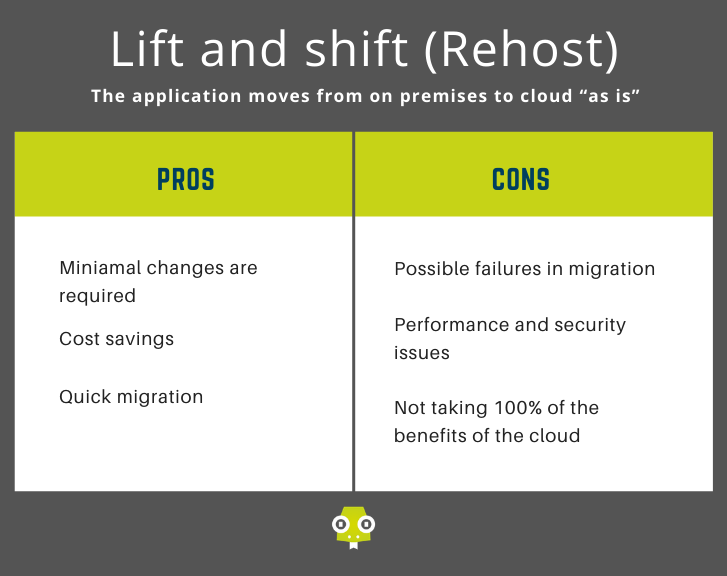If you are considering migrating to the cloud , you have probably considered the “lift and shift” option, migrating to the cloud without redesigning the architecture or optimizing it for hosting in the cloud environment. Opting for this type of strategy is not always the best option, depending on the needs of your business and its possible application. From Geko we want to explain the advantages and disadvantages of applying this migration model.
Advantages
- Minimal changes to be made: One of the most outstanding features of the lift and shift approach is the lack of need for large-scale changes to both the application and the architecture. The application is completely re-hosted in the cloud using the IAAS platform and therefore no redesign of the application architecture itself is required. As a result, there are no additional costs in migrating to the cloud. Obviously, we will have to control all access to endpoints and dependencies in calls to applications. In this case, we do recommend using all possible SAAS services that provide us with simplicity, such as cache systems, databases, etc.
- Cost savings: Another point to highlight are the costs in the migration model “lift and shift”, as the above-mentioned changes are not required, the costs are reduced. In addition, migrating to the cloud faster also reduces management and maintenance costs, improving business performance.It is important to be clear about this cost associated with hardware maintenance, as it is much more than companies are aware of. Being able to host the legacy platform in a new environment with dynamic growth features allows us to use and pay only for the resources that are really needed instead of having to host it on servers that are sized to the maximum.
- Quick migration: If you want to move all your resources or applications out of the local infrastructure and into a cloud environment quickly, the “lift and shift” model is the solution, as there is no time spent optimizing, changing code, or even making major architectural changes. This advantage is very beneficial for companies that cannot afford long periods of downtime during migration. However, we recommend planning before starting the migration process to the cloud. On the other hand, there are more and more applications that allow us to clone operating systems to export and import them in exactly the same state as they are on-premise.
Disadvantages
- Migration failures: When migrating with a “lift and shift” strategy, it must be taken into account that on-premise architecture is not the same as a cloud architecture, so if organisations do not translate the corresponding application features to the cloud, the cloud migration process is doomed to fail and there will be major problems in the long-term, such as load peaks. This point is ultimately to understand that it is imperative to have control and knowledge about the application(s), their configurations, dependencies, network infrastructure and segmentation, and other characteristics that need to be taken into account.
- Performance problems: Copying applications without making changes means that you will have performance or latency issues after migration, particularly those businesses that use a lot of resources or are based on big data analytics. The cloud brings us dynamic growth, but in the cost matrix, the cloud loses efficiency the more raw computation is needed, or rather, the more resource performance, IO, CPU, RAM the application or product to be deployed requires.
- Security issues: Another disadvantage of not making any changes to the infrastructure is that many of the problems of the previous IT model, such as insecure configurations or malware, will be carried over, which can lead to increased risks after migration. To counteract the inherent inefficiencies, contingency measures must be implemented and, in addition, risk management and security policy compliance must be implemented.
- Not taking 100% of the benefits of the cloud : By keeping the same application architecture, it will not be possible to take advantage of all the benefits that migrating to the cloud can offer, such as scalability, the use of SAAS services and, in short not proceeding with a “cloud-friendly” migration using the resources that the provider makes available to achieve the associated competitive advantages. Many companies have applications or programmes designed in a local environment to cope with increases, such as seasonal peaks. So if you use the “lift and shift” approach, you can’t benefit from the ability to scale the capacity up or down on demand, as well as the speed and agility that the cloud offers. Also, if the application is not optimised for the cloud, it could consume more resources than necessary, and therefore could increase costs in the long run.

The choice of the right migration method is crucial, as every company has different needs. If the “lift and shift” method of migration is finally chosen, not only the advantages (cost-effectiveness, ease and speed) but also the disadvantages (migration failures, additional costs or performance problems) must be taken into account.
To take full advantage of the benefits offered by the cloud, it is important to have a team of experts in cloud infrastructure and development. Geko‘s team has experience in different areas, working with DevOps methodology and guaranteeing our clients 100% adaptation to their infrastructures and technologies when migrating to the cloud.
Contact us to analyse your infrastructure and migrate to the cloud in the most efficient way!

